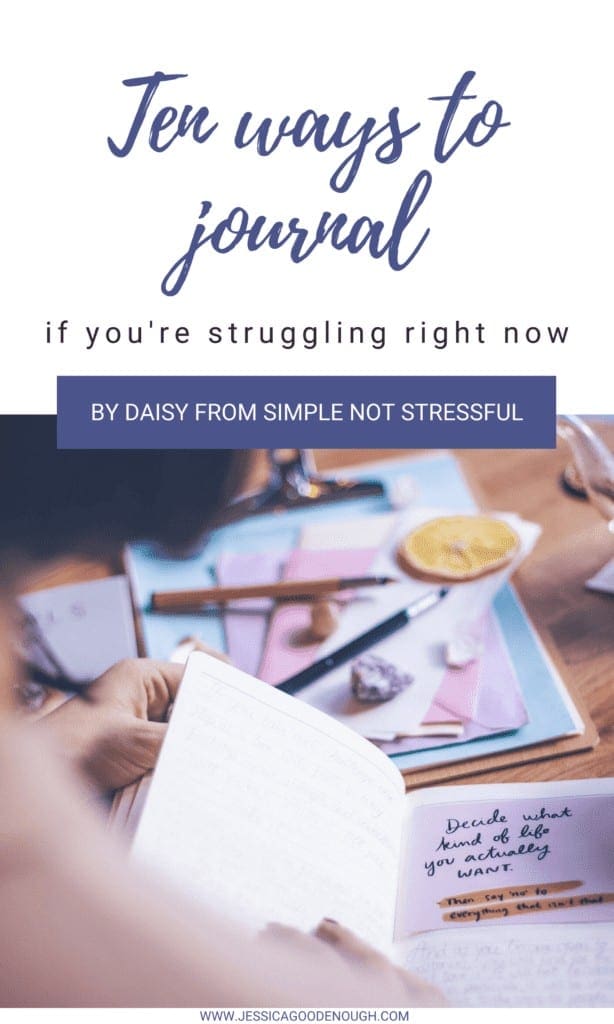Hello friends! I’m delighted to bring you my first blog crossover! This blog post is written by Daisy and is the first part of a collaborative effort between her and me (Jessica!). Read this, then hop over to part two, written by me, on her blog! Right, over to Daisy:
The last six months have been a journey, haven’t they?
From COVID-19 to the Black Lives Matter movement to the many other issues going on around our world and in our own backyards, so much is happening around us. Not to mention the relationship, work, and money problems you and I might have right now.
We’ve always known there are things we can’t control in life, but that truth is more visible now.
That uncertainty is stressful, and we’ve all been coping with it in different ways.
Maybe you’ve cleaned more, created more, planned more for when all this is over. You might be spending more time with your loves (An important aside, isn’t Jessica’s kiddo adorable? *heart-eyed emoji*) or clinging to your spiritual faith.
Or maybe you just can’t, and after the chores and family stuff are done, you’re in bed exhausted. You’re choosing to take care of yourself at this time, and that’s okay too.
Whether you’re tackling new projects or feeling really unproductive, one thing is true: you and I are having a lot of anxious thoughts right now.
Jessica and I have found that journaling can help with processing those thoughts and improving your mood.

So with pen and paper, I encourage you to find a quiet corner (or at least, put on earphones while your partner holds down the fort and the kids are napping). It can be as short as ten minutes or as long as you like.
Choose to be honest with yourself in this short time, to write how you really feel and be messy about it. There are no wrong answers and no one else has to see what you wrote.
Telling the truth on paper will help you take a mental step back and show you exactly where you are. Then you can let go of the thoughts that don’t serve you in this season.
After you’ve found that corner and decided to be real on paper, skim over my five best journal prompts that help when you’re struggling.
Just pick one and start.
My five best journaling prompts for when you’re struggling
What’s possible now?
We’ve asked ourselves “What’s happening now?” a lot this year. Instead, let’s rephrase the question to “What’s possible now?”
What can you do now? Can you go on more walks? Can you have home-cooked meals together as a family? Can you linger in conversation with the people you love?
No answer is too big or too small. It all counts.
This prompt is great for shifting your thoughts from what you can’t control – and therefore can’t change – to what you can do, even when you’re struggling.
Often, the little things have the biggest effect on rough days.
What’s stressing me out? In what way is this obstacle an unintended opportunity?
Every, and I mean every, obstacle is an unintended opportunity. It might be an opportunity to do better, to change your plans, or to practice virtues like love and kindness.
Obstacles are less anxiety-inducing when you change your story around them. Pushing through is hard, but can getting around the problem be intriguing? You’re afraid but can you practice not letting fear influence you anyway?
Maybe this difficult person is someone else going through a hard thing, and now’s a chance to hold space for them. What if that fight is an opportunity to be open together about recurring issues bothering you?
Reframing stressful obstacles in your life helps you dream about the possibilities. And then you take a step forward and grow.
What am I putting off? When will I do it?
If your mind immediately went to that one annoying task, that’s your answer. It could be a phone call to make, the laundry to fold, or the sensitive concern you need to bring up. It’s something you’ve been meaning to do for ages but never got around to because… just because.
If it was only one niggling task, that’s fine. But you and I often have lots of little “I really should get back to that” thoughts that bother us through the day. When you’re already struggling, these tasks just add to the stress.
You’ve put it off enough. Wouldn’t it be wonderful to let go of it like a heavy bag you can finally put down?
Decide when you’re going to do that one thing. Which day of the week and what time? What would you need to prepare before you start?
Write those details down and treat it like an appointment with someone else. And when it’s finished, enjoy that relieved feeling and move on with your life.
What can I choose not to do?
The world teaches us to quit is to fail. When we give up, we often feel ashamed.
But when you and I want to say yes to what’s best, it always means saying no to other good things. Always.
It’s just the consequence of the 24 hours a day everyone has. There’s enough time for the important things, but not for everything plus staying sane at the same time.
So quitting intentionally is important. It can even feel liberating.
For example, here are a few things I’ve quit:
- On weekdays, I don’t watch or stream shows. If something looks interesting, I’ll note it for Saturday.
- I don’t shop unless something I use needs to be replaced. So that means no window shopping online most of the time.
- I opted out of some groups I was more active with in my twenties. They were lovely but in this season, I’m choosing to not make time for them anymore.
I’ve quit commitments like these to make time for what I want more of. Things like building meaningful relationships, reading good books, and writing posts like this one.
I don’t regret any of it. And when I see something I’m missing because I opted out? That’s okay because there are other things I’ve made room for instead.
So what will you choose not to do today? What will you let go of that wasn’t helpful anyway?
How do I want to feel this week?
This is my favorite thing to journal about on Sundays. It might seem a bit weird to imagine how you want to feel, but it helps us approach problems with intention during the week.
Our feelings come from our thoughts, which is why you and I can act the same way and feel so different about it. We can use that connection between thoughts and feelings to make things easier for ourselves.
For example, I’m going back to school this fall. As you can imagine, that transition is nerve-wracking in the middle of a global pandemic. Adjusting to learning online instead of face-to-face, moving closer to school, leaving my job on purpose when others are being laid off—I signed up for a change, but not this much change!
Then I sat down with this prompt and decided: I choose to feel excited. Excitement and anxiety both involve sweaty palms, a racing pulse, and nerves anyway. It won’t be a huge stretch.
That shift worked. I started finding the transition exciting, thinking about how I really want this and how I’m growing through the bumpy ride. I compared it to a roller coaster ride: dips and climbs can be fun!
The problems didn’t go away for me, and yours won’t either. But choosing to feel differently about them makes such an impact. You’re going to have problems either way; the experience might as well be less stressful.
So how do you want to feel this season? You choose.
Those were five prompts you can journal about that will help you evaluate the stress you’re carrying.
Because there are some things you can’t control, but your thoughts and feelings? You can change them and live your best life, even in a tough season.
Did you like that post?
Then you might enjoy Daisy’s free email course, Busy Without The Crazy. It’s an eight-day course that shows you the simple way to downsize that overwhelming To Do list.
When you sign up, you get eight short lessons in your inbox that lead you from crazy busy to making things happen with much less stress. It’s how Daisy went from clinically anxious workaholic to an intentional (and calm!) minimalist today.
And yes, it’s free!
If that sounds interesting, find more details on Busy Without The Crazy at Daisy’s site Simple Not Stressful.



![Only a month late... Here are our Valentine's Day photos! 👩🏼❤️💋👨🏻😅
We've been on a bit of a Caribbean kick (say that 10 times!) since watching the One Love film about Bob Marley on Valentine's Day + @gazoakley's adventures in Jamaica on the YouTubezz. 🇯🇲
So far we've eaten at @turtlebayuk [apologies for the blurry photos, I took them before getting my new @fairphone!] and ordered from Pappy's Afro Caribbean Takeaway (don't think they're on Instagram)... Next step is to make it at home; any recipe recommendations? 😘
#PlantBased #JamaicanFood #CaribbeanFood #OneLove](https://jessicagoodenough.com/wp-content/plugins/instagram-feed/img/placeholder.png)
Leave a Reply
You must be logged in to post a comment.